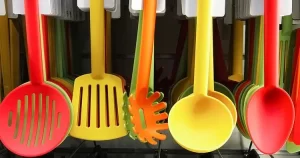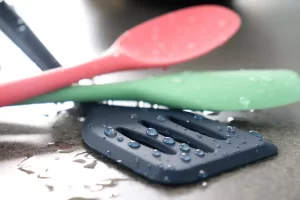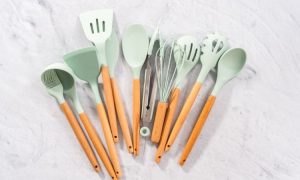Silicone Cooking Utensils: Silicone Cooking Utensils
Silicone Cooking Utensils
Silicone cooking utensils have become increasingly popular in modern kitchens due to their versatility, ease of use, and heat-resistant properties. These utensils are made from food-grade silicone, a flexible and durable material. In the modern kitchen, silicone cooking utensils have become essential tools for professional chefs and home cooks. These versatile and durable kitchen companions have gained popularity for their many benefits. In this comprehensive guide, we’ll explore the world of silicone cooking utensils, from their advantages and uses to maintenance tips and more.
Here are some everyday silicone cooking utensils you might find in a kitchen:
Silicone Spatula: Silicone spatulas are excellent for scraping bowls, pans, and pots, as they are heat-resistant and won’t scratch non-stick surfaces. They come in various shapes and sizes for different tasks. Also, read about Wooden Cooking Utensils: The Beauty and Benefits
Silicone Turner: These are designed for flipping and turning food items like pancakes, burgers, and eggs. They have a flat, wide surface that makes flipping delicate foods easy.
Silicone Tongs: Silicone-tipped tongs provide a firm grip on food items and are perfect for handling hot ingredients while cooking, grilling, or serving. They won’t damage your cookware.
Silicone Basting Brush: Silicone brushes apply marinades, sauces, or oil to food while cooking. They are easy to clean and can withstand high temperatures.
Silicone Whisk: Silicone whisks are designed to mix ingredients in hot and cold dishes. The silicone wires are gentle on non-stick pans and won’t scratch them.
Introduction to Silicone Cooking Utensils
What Are Silicone Cooking Utensils?
Silicone cooking utensils are kitchen tools made from food-grade silicone, a synthetic material known for its remarkable heat resistance and flexibility. These utensils come in various forms, such as spatulas, tongs, whisks, ladles, basting brushes, and cooking spoons. Discover more about Can You Eat Coffee Beans: A Delectable Delight
Advantages of Silicone Cooking Utensils
Silicone utensils offer several advantages:
- Heat Resistance: Silicone can withstand high temperatures, making it ideal for cooking and baking.
- Non-Stick Properties: Silicone’s non-stick surface is gentle on cookware and won’t scratch non-stick pans.
- Durability: These utensils are highly durable and can last for years.
- Easy to Clean: Silicone utensils are easily cleaned by hand or in the dishwasher.
- Food Safety: Silicone is non-toxic and safe for food contact, ensuring your dishes remain safe.
In the following sections, we’ll explore the different types of silicone cooking utensils and their various uses.

Types of Silicone Cooking Utensils
Silicone cooking utensils come in various options, each designed for specific cooking tasks.
Silicone Spatulas
Silicone spatulas are perfect for flipping pancakes, scraping bowls, and stirring sauces. Their flexible heads make it easy to reach every corner of your cookware.
Silicone Tongs
Silicone-tipped tongs provide a firm grip on food items, making them excellent for flipping meats on the grill or tossing salads.
Silicone Whisks
Silicone whisks are great for whipping eggs, batter, or sauces without scratching your mixing bowls or pots.
Silicone Ladles
Silicone spoons are perfect for serving soups, stews, and sauces, as they won’t scratch your pots or pans.
Silicone Basting Brushes
Silicone basting brushes are ideal for applying marinades, sauces, or butter to your grilled or roasted dishes.
Silicone Cooking Spoons
Silicone cooking spoons are versatile tools for stirring, serving, and mixing various dishes.
The following section will discuss why you should consider using silicone cooking utensils.
Why Choose Silicone Cooking Utensils?
Silicone cooking utensils have gained immense popularity, and for good reason. Let’s explore the compelling reasons to choose them for your kitchen.
Heat Resistance
Silicone cooking utensils can withstand high temperatures, typically up to 600°F (315°C). This exceptional heat resistance allows you to use them in various cooking methods without worrying about melting or warping.
Non-Stick Properties
One of the standout features of silicone utensils is their non-stick nature. Using silicone utensils with non-stick cookware won’t damage the pan’s surface or leave scratches behind.
Durability
Silicone utensils are built to last. They are resistant to wear and tear, making them a long-term investment for your kitchen.
Easy to Clean
Cleaning silicone utensils is a breeze. Wash them with warm, soapy water or toss them in the dishwasher for hassle-free cleaning.
Food Safety
Silicone is food-grade and non-toxic, ensuring your cooking remains safe and free from harmful chemicals.
In the upcoming sections, we’ll discuss how to use silicone cooking utensils effectively and how to care for them to prolong their lifespan.
Using Silicone Cooking Utensils
Silicone cooking utensils are incredibly versatile and can be used for various cooking and baking tasks. Let’s explore how to use them effectively.
Cooking with Silicone Utensils
You can sauté, stir-fry, or flip food items without scratching your pans when cooking with silicone utensils. The non-stick surface ensures smooth cooking and easy food release.
Baking with Silicone Utensils
In baking, silicone spatulas and whisks are invaluable tools. They help you mix the batter, scrape bowls clean, and ensure an even distribution of ingredients.
Caring for Your Silicone Utensils
To prolong the lifespan of your silicone utensils, it’s essential to care for them properly. Avoid exposing them to direct flames or extremely high heat, which can damage them over time. Additionally, follow the manufacturer’s instructions for cleaning and maintenance.
In the following section, we’ll compare silicone cooking utensils to utensils made from other materials.

Silicone vs. Other Utensil Materials
Silicone cooking utensils have unique advantages, but how do they compare to those made from other materials like plastic, wood, and stainless steel?
Silicone vs. Plastic Utensils
While plastic utensils are affordable, they lack silicone’s durability and heat resistance. Silicone utensils are a better choice for high-temperature cooking.
Silicone vs. Wooden Utensils
Wooden utensils are gentle on cookware but may absorb odors and stains. Silicone utensils, on the other hand, are non-porous and resistant to staining.
Silicone vs. Stainless Steel Utensils
Stainless steel utensils are durable but can scratch non-stick surfaces. Silicone utensils offer the best of both worlds: durability and non-stick properties.
In the next section, we’ll introduce you to some popular brands of silicone cooking utensils.
Popular Brands of Silicone Cooking Utensils
Several reputable brands offer high-quality silicone cooking utensils. Here are a few worth considering:
OXO Good Grips
OXO Good Grips is known for its ergonomic and user-friendly designs. Their silicone utensils are no exception, offering comfort and durability.
KitchenAid
KitchenAid’s silicone utensils are stylish and functional, perfect for cooking and serving.
All-Clad
All-Clad’s silicone tools are designed to complement their premium cookware. They offer precision and durability for your culinary adventures.
Tovolo
Tovolo’s silicone utensils come in a variety of fun colors and designs. They are perfect for adding a touch of style to your kitchen.
Joseph Joseph
Joseph Joseph’s innovative designs make cooking even more enjoyable. Their silicone utensils are both practical and visually appealing.
In the subsequent section, we’ll provide tips on cleaning and maintaining your silicone utensils.
How to Clean and Maintain Silicone Utensils
Keeping your silicone utensils clean and well-maintained ensures their longevity. Here are some tips on how to do it:
Dishwasher-Safe Cleaning
Many silicone utensils are dishwasher-safe, making cleanup a breeze. Check the manufacturer’s instructions to confirm if your utensils can be safely washed in the dishwasher.
Hand Washing
If your silicone utensils are not dishwasher-safe, simply hand wash them with warm, soapy water. Use a soft sponge or cloth to remove any food residue.
Storing Silicone Utensils
Store your silicone utensils in a drawer or utensil holder to prevent deformation. Avoid leaving them in direct sunlight or near a heat source.
The following section will explore some creative and unconventional uses for silicone cooking utensils.

Creative Uses for Silicone Cooking Utensils
Silicone cooking utensils aren’t just for the kitchen; they can also be handy in other aspects of your life.
Crafting
Silicone spatulas and brushes are great for mixing and applying paint, glue, or other crafting materials.
Beauty Applications
Small silicone spatulas can scoop out the last bits of skincare products from their containers, reducing waste.
Household Tasks
Silicone utensils can help with household tasks like spreading adhesive or grout evenly. Now that you’ve learned about the versatility of silicone cooking utensils, it’s time to wrap up our guide.
Conclusion
In conclusion, silicone cooking utensils are invaluable tools that bring convenience and versatility to your kitchen. Their heat resistance, non-stick properties, and durability make them a wise choice for novice and experienced cooks. By choosing high-quality silicone utensils and maintaining them properly, you can elevate your culinary experience.
Embrace the benefits of silicone cooking utensils and revolutionize your cooking and baking endeavors. Make them a staple in your kitchen, and you’ll wonder how you ever cooked without them!
FAQs
1: Are silicone cooking utensils safe for children to use?
Yes, silicone cooking utensils are safe for children to use. Their non-toxic nature and heat resistance make them suitable for young chefs learning their way around the kitchen.
2: Do silicone utensils retain odors?
Silicone utensils are non-porous, meaning they are less likely to retain odors than wooden or plastic ones. A quick wash should remove any lingering smells.
3: Can silicone utensils withstand high temperatures?
Yes, silicone utensils are heat-resistant and can withstand temperatures up to 600°F (315°C), making them suitable for various cooking methods.
4: Are there any limitations to using silicone utensils?
While silicone utensils are versatile, they may not be suitable for open flames or direct contact with extremely high heat sources.
5: What colors are silicone cooking utensils available in?
Silicone cooking utensils come in a wide range of colors, allowing you to choose options that match your kitchen’s decor or your style.
